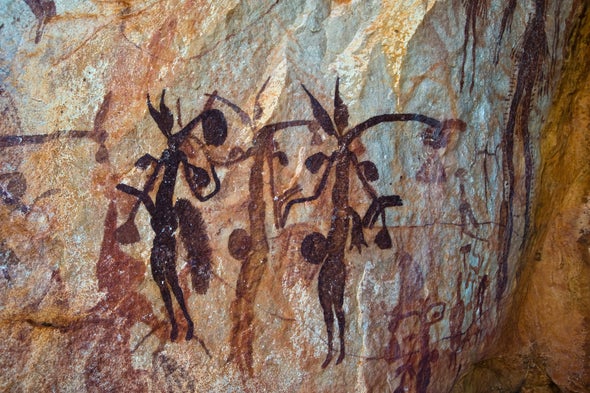(单词翻译:单击)
听力文本
This is Scientific American's 60-second Science, I'm Susanne Bard.
Thousands of years ago, in what's now the Kimberley region of Western Australia, Aboriginal artists created elaborate rock paintings. Much of the artwork still exists today.
"If you're walking beside the rivers and creeks and go up into the escarpments, into rock shelters, there are just thousands of rock art sites."
University of Melbourne geochronologist Damien Finch. The oldest paintings depict plants and animals. But later works show human figures in ceremonial attire and ornate headdresses.
"And then, around the arms and the elbows and the knees, there's decorations. And sometimes they'll be holding a clutch of boomerangs. And very often, they're very finely executed, using quite long and elegant-looking brushstrokes."
The human-centered paintings represent what's known as the Gwion style. How old the artwork is has remained a mystery, however. That's because the typical method for estimating the age of ancient objects—radiocarbon dating—relies on the presence of organic carbon. But the artists used ocher pigments that had no organic carbon.
"There is nothing organic that we can apply carbon dating to. So the only thing that we can do is look for stuff that's either been constructed on top of or underneath the paintings."

That's where mud wasps come in. The insects often incorporated organic matter into their nests, which they built on the same rock faces where artists painted. The artists would sometimes paint right on top of old nests. Finch and his colleagues were thus able to date the artwork by sampling the remains of those nests.
"If it was over the top of the painting, that tells us that the painting has to be older than that nest. But if the nest was underneath paint, the painting must be younger than the age that we determined for that nest. And in that way, we can help to build up an idea of when these paintings were created."
The analysis revealed that most of the Gwion style paintings sampled were about 12,000 years old.
"So now we can place that in the context of all the other archaeological and environmental information that we've got for the Kimberley region at that time."
The study is in the journal Science Advances.
The results provide support for the hypothesis that Aboriginal artists may have switched from painting plants and animals to depicting humans in ceremonial dress around 12,000 years ago in response to the ecological changes and rapidly rising sea levels as the last ice age ended.
Finch is now working out the age of other styles of Aboriginal rock art—with a little help from materials that ancient insects once called home.
Thanks for listening for Scientific American's 60-second Science. I'm Susanne Bard.
参考译文
这里是科学美国人——60秒科学系列,我是苏珊娜·巴德。
数千年前,土著艺术家在如今西澳大利亚州的金伯利地区绘制了精美的岩画。许多艺术品至今仍然存在。
“如果你沿着河流和小溪,爬上悬崖进入岩石掩体,会发现数千处岩画遗址。”
墨尔本大学的地质年代学家达米安·芬奇说到。最古老的岩画描绘的是植物和动物。但后来的作品描绘了着礼服、戴华丽头饰的人类形像。
“手臂、手肘和膝盖周围还有装饰品。有时他们还会拿着一些回旋镖。通常,绘画者非常擅于使用绵长且优雅的笔触。”
以人类为中心的绘画是Gwion风格。然而,这些绘画的年龄仍然是谜。这是因为估算古代物体年龄的典型方法是放射性碳定年法,而这种方法依赖于有机碳的存在。但艺术家使用的赭石颜料不含有机碳。
“我们没有可供放射性碳定年法使用的有机物。因此,我们唯一能做的就是寻找建在岩画上面或下面的东西。”
这时泥蜂就派上用场了。这种昆虫经常将有机物混入蜂巢,而且它们就在艺术家绘制的岩画上筑巢。艺术家有时会在老蜂巢上面作画。因此,芬奇和同事能够通过采集蜂巢的剩余物样本来测定画作的年代。
“如果蜂巢位于岩画上方,说明岩石比蜂巢更古老;但如果蜂巢在岩画下方,那岩画的年代肯定早于我们判定的蜂巢的年代。通过这种方法,我们可以帮助树立一种观念,大致确定岩画绘制的时间。”
分析显示,大多数Gwion风格岩画样本有12000年左右的历史。
“因此,现在我们可以将岩画与我们掌握的古代金伯利地区的所有其他考古和环境信息结合起来。”
这项研究发表在《科学进展》期刊上。
研究结果支持了一种假设,即大约12000年前,土著艺术家从绘制动植物转为描绘身着礼仪服装的人类,是为了应对最后一次冰河时期结束时的生态变化和海平面迅速上升。
芬奇现在正在借助古代昆虫曾当作家的材料,计算土著岩画其他风格的年代。
谢谢大家收听科学美国人——60秒科学。我是苏珊娜·巴德。
译文为可可英语翻译,未经授权请勿转载!
重点讲解
重点讲解:
1. a clutch of 一小群;一小簇;
The party has attracted a clutch of young southern liberals.
聚会吸引了一群南部的年轻开明人士。
2. on top of 在上面;在顶上;
She wore her hair loosely knotted on top of her head.
她在头顶上打了个松松的发髻。
3. in response to 回应;
Sudan even threatened to mobilize in response to the ultimatums.
作为对最后通牒的回应,苏丹甚至威胁说要动员军队。
4. work out 计算出,解出;
We need to work out the best fit between the staff required and the staff available.
我们必须算出所需人员与现有人员之间的最佳搭配。


